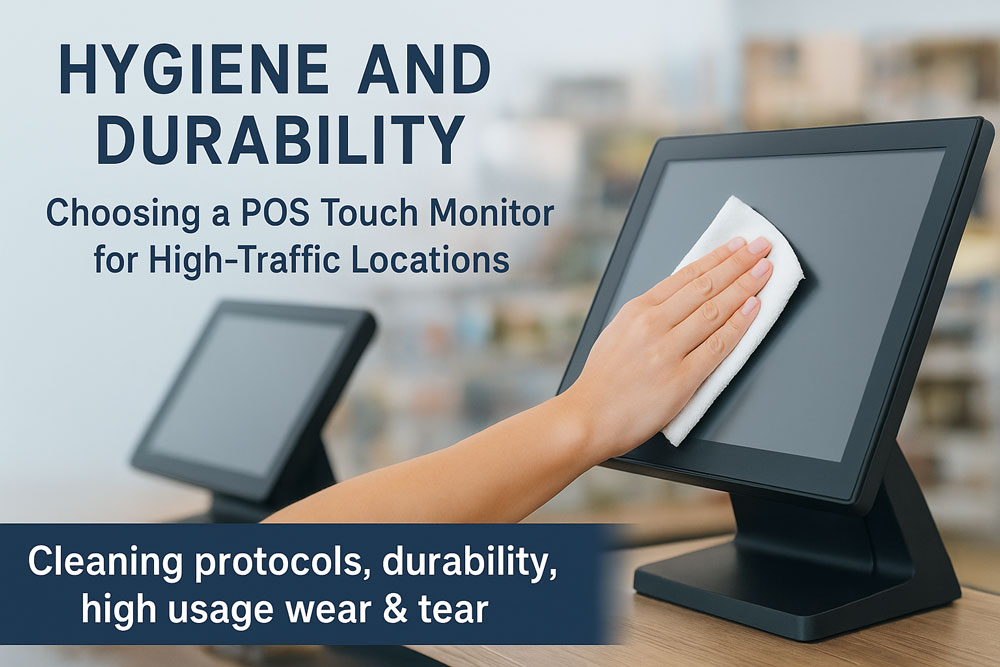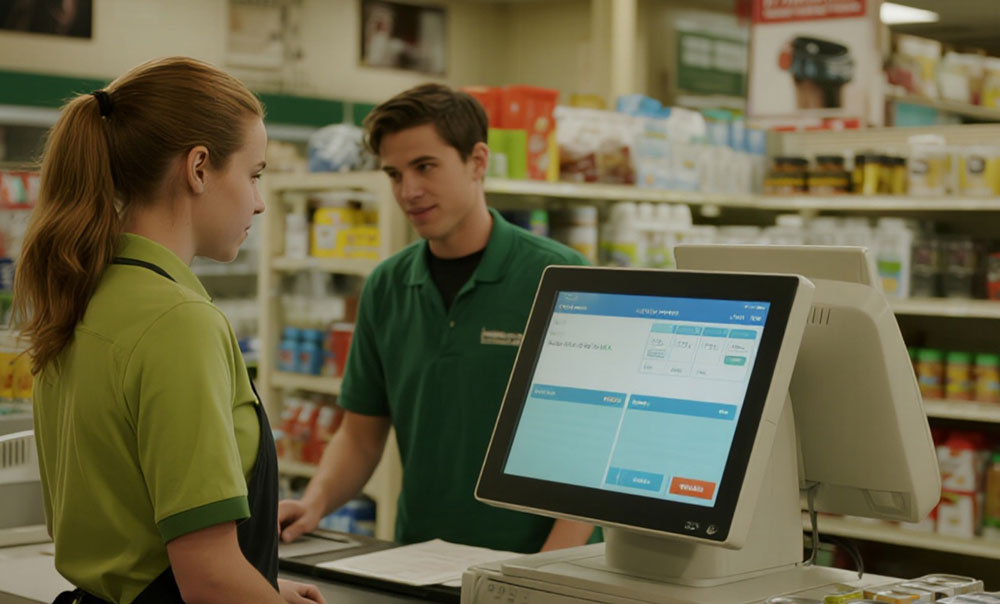What Are You Looking For?
In today’s post-pandemic retail and hospitality environments, the importance of hygienic, durable hardware can’t be overstated. Point-of-sale (POS) touch monitors face constant exposure: hundreds, if not thousands, of interactions per day, cleaning with disinfectants, and occasional spills, dust, or high humidity. For businesses operating in such demanding settings, selecting a monitor that holds up both in cleanliness and long-term reliability is vital. One manufacturer that stands out in industrial-grade touch displays is Oscymonitor, whose rugged designs align well with the need for hygiene and durability.

Increased Touch Frequency
High-traffic POS terminals see heavy use. Fast-food counters, retail checkout lanes, self-service kiosks—all these environments demand touch monitors that can take repeated interactions without performance degradation.
Rigorous Cleaning Protocols
In the post-COVID world, cleaning protocols have intensified. Surfaces must tolerate frequent disinfection cycles, often using alcohol-based or hospital-grade cleaners. Poorly designed monitors can cloud, crack, or suffer touch-accuracy loss.
Wear and Tear
Beyond cleaning, POS monitors must endure knocks, pressure, and sometime elevated moisture. Hardware failure or screen damage can lead to costly downtime, loss of sales, or even reputational harm.
Thus, businesses must prioritize touch-monitor solutions engineered to be both rugged and cleanable.
Oscymonitor is the brand of Shenzhen Oscan Electronics Co., Ltd., a company with over 14 years of experience in industrial LCD and touch-screen manufacturing.
Here’s how their design philosophy aligns with high-traffic, hygiene-conscious deployments:
Industrial-Grade Components & Certifications
Oscymonitor uses high-quality, industrial-grade parts. Their products carry certifications such as IEC 62368, CE, RoHS, and CCC, which reflect robust design practices suitable for demanding environments.
Broad Operating Ranges
Their monitors are built to withstand wide ranges of temperature and humidity, making them suitable not only in clean retail stores but also in less controlled environments.
Rugged Touch Technologies
According to their guide on choosing the right industrial touch monitor, Oscymonitor supports infrared (IR) touch: a non-physical touch layer that is highly durable, scratch-resistant, and works with gloves or stylus. Oscy Monitor
IR touch is beneficial in hygiene-critical settings because it avoids the use of delicate coatings or membranes that degrade over time.
Their use of industrial open-frame designs further increases durability and allows for customization in kiosk or countertop installations.
Scalable Production & Customization
Oscymonitor claims a monthly production capacity of about 8,000 units, plus over a decade of ODM/OEM experience. Oscy Monitor This lets them support large-scale deployments, and their team can tailor specifications (size, voltage range, interface) to specific use cases.
Even with rugged hardware, proper maintenance is essential. Here are considered recommendations based on both general industrial-monitor guidance and the particular challenges of high-traffic POS settings:
Follow Manufacturer Guidelines
Use cleaning materials that won’t degrade the touch surface. For many industrial monitors, soft, lint-free microfiber cloths with distilled water or mild, non-abrasive cleaning solutions are safest.
Power Down Before Cleaning
Always turn off the display (and unplug, if possible) before wiping the screen. This minimizes risk of short circuits and avoids triggering unwanted touch inputs.
Use the Right Cleaning Frequency
In high-touch POS environments, daily or weekly cleaning often makes sense. But it should be balanced: overly aggressive cleaning can stress the seals or edges of an industrial monitor, leading to moisture ingress or component fatigue.
Be Careful Around Seals and Borders
Many industrial monitors, including those from Oscymonitor, are sealed to protect against dust and moisture. When cleaning, avoid liquid pooling near edges or ports.
Train Staff
Employees should be trained not only on cleaning frequency, but also on which products to use and how to apply them (cloth-first, not spray directly). Over time, such routines extend the monitor’s operational life and maintain touch accuracy.
To contextualize Oscymonitor’s offerings, consider these alternative POS touch-monitor options:
Oscy 19″ LCD LED POS Touch Monitor — A large-form industrial touch monitor from the same Oscymonitor/Oscan product line, suited for high-visibility or back-office terminals.
Oscy 12″ Touch‑Screen Monitor — Compact but still rugged, ideal for smaller countertop or embedded POS systems.
15″ Touch‑Screen LED POS Monitor — A mainstream countertop model suitable for retail checkouts or restaurant counters, though likely less rugged than Oscymonitor’s industrial line.
17.3″ Industrial‑Grade Waterproof POS Monitor — Features water and dust resistance, highlighting how other manufacturers are also adapting to hygiene demands in POS hardware.
When comparing, observe not just initial cost but total cost of ownership (TCO): rugged industrial monitors like those from Oscymonitor may cost more upfront but can save significantly by reducing replacement, downtime, and maintenance costs in high-use settings.

If you’re a business leader specifying POS hardware for high-traffic, hygiene-focused environments, here is a recommended strategic approach:
Assess Your Environment
Estimate daily touch count.
Quantify cleaning frequency.
Determine environmental stressors (e.g., humidity, dust, temperature swings).
Match Monitor Specs to Requirements
Choose touch technology to minimize wear (IR is strong for durability).
Ensure IP or sealing rating is sufficient if the environment requires wash-down or is dusty.
Confirm operating temperature/humidity tolerances.
Vet Manufacturer Credibility
Oscymonitor brings 14 years of industrial LCD expertise.
Validate certifications (e.g., IEC 62368, CE, RoHS) for safety and compliance.
Confirm supply capacity for your scale.
Implement Maintenance Protocols
Develop a cleaning SOP aligned with manufacturer recommendations.
Train staff rigorously.
Monitor wear or performance degradation (particularly around edges, touch responsiveness) and schedule periodic hardware audits.
Monitor and Iterate
After deployment, track failure rates, touch responsiveness issues, and maintenance costs.
If problems arise, work with the manufacturer (such as Oscymonitor) to adjust or customize future orders to reduce failure.
In post-pandemic retail and service settings, POS touch monitors must be more than just responsive: they must be hygienic, rugged, and built for longevity. Oscymonitor, with its industrial-grade LCDs, broad environmental tolerances, and durable touch technology, offers compelling solutions for high-traffic deployments. By combining thoughtful hardware selection with disciplined cleaning protocols, businesses can minimize downtime, protect customer health, and optimize the total cost of ownership for their POS infrastructure.